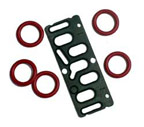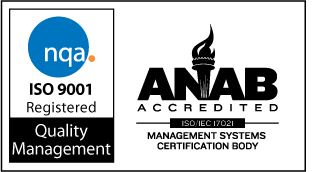
|
7108
S. Alton Way, Unit I |
(303) 758-2728
Home > Elastomers > Neoprene Seals
Neoprene
O-rings and Seals
(also called CR or Chloroprene)
The first synthetic rubber developed for commercial use was neoprene. It was developed by DuPont in the early 1930's. Today the name neoprene refers to a whole a group of synthetic rubbers that are produced by the polymerization of chloroprene. This process yields a large family of compounds with many different chemical and physical properties. Some of these neoprene compounds are used in the manufacture of o-rings and seals and some are used for other purposes (such as wet suits, electrical insulation and cell phone cases).
The low gas permeation and chemical inertness of neoprene make it an ideal elastomer for use in o-rings and seals. There are thousands of applications for neoprene o-rings and seals. For example, because of its good resistance to Freon and ammonia, refrigeration systems use neoprene seals and o-rings. Because neoprene is resistant to flames, weather stripping in fire doors is often made from it. It is common for outdoor applications to utilize neoprene o-rings and seals since neoprene has excellent resistance to UV rays, ozone, oxygen and sunlight.
In general, neoprene o-rings and seals are known as general purpose o-rings and seals are tough, abrasion resistant and have a low compression set. Since neoprene has an outstanding ability to adhere to metals, it is widely used for rubber to metal bonding applications.
Overview of the Major Benefits Of Neoprene O-rings and Seals for Industrial Sealing Applications.
- Resist damage from weather, UV rays, ozone, oxygen and sun.
- Resist petroleum oils and chemicals.
- Are physically tough.
- Resist cracking from twisting and flexing.
- Operate over a wide temperature range.
- Display more resistance to flames than hydrocarbon rubbers.
- Are a cost-effective solution for many applications.
When you touch Neoprene you will notice it has a springy consistency to it. You can compress it with your fingers and the elastomer pops right back to the same size when you release it. O-rings and seals made from it come in many colors including white, black, yellow, blue and rusty red. They are available in a range of durometers from Shore A 30 to 90.
Neoprene o-rings are sometimes referred to as a chloroprene o-rings or CR o-rings. We offer them in standard AS568 sizes and metric sizes. Of course, we can manufacturer them in any size for any application.
Custom Rubber to Metal Bonded Parts Made to Your Specifications.
We work with our customers to develop custom o-rings and seals including rubber to metal bonded parts. Please e-mail or call and ask for Bill to discuss the details of your application.
More information on applications Neoprene O-rings and Seals Tips.
Next Topic History of Polymers
* Copyright © Photographer: David Lemery of Milpitas, California, USA
We are located in the Denver Technological
Center in a suburb of Denver, Colorado
©1997-2017, Problem Solving Products, Inc.
Website Map | Privacy Statement
| Terms of Use



